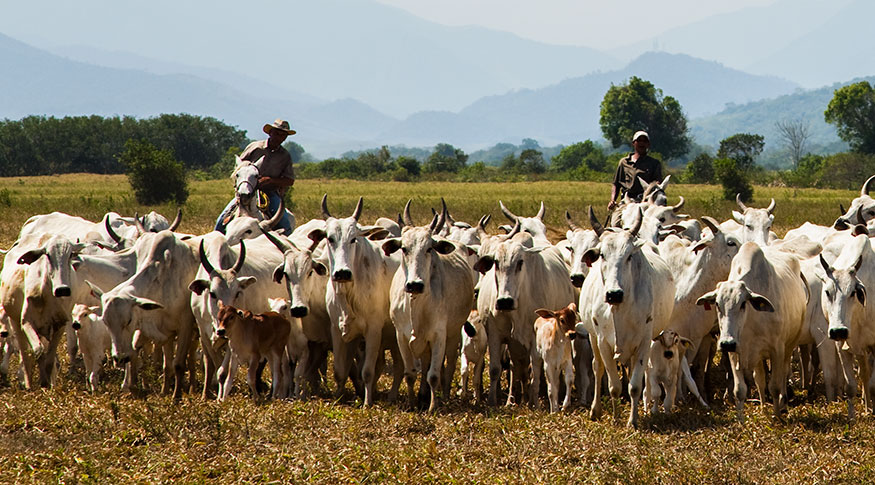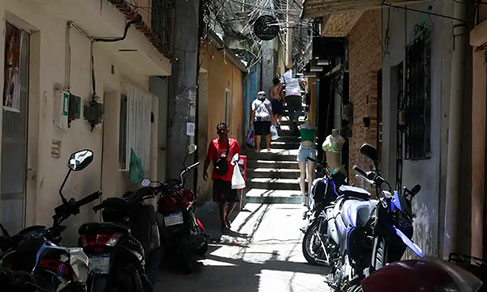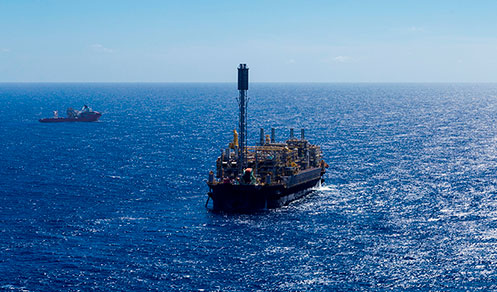Municipal Livestock Survey
Cattle herd records slight increase in 2019, after two straight years of decrease
October 15, 2020 10h00 AM | Last Updated: October 16, 2020 10h13 AM
Highlights
- With 214.7 million head, cattle herd increased by 0.4% in 2019, with a highlight to the municipality of São Félix do Xingu (PA).
- Cow milk production expanded 2.7% and amounted to 34.8 billion liters. The Southeast tops the production ranking once more.
- The inventory of hogs and pigs fell by 1.6%, and has a total 40.6 million head.
- Production of hen eggs increased by 4.2% and hit 4.6 billion dozens.
- Led by Paraná, fish farming grew 1.7% and reached 529.6 thousand metric tons.
- Captive shrimp production rose for the second year in a row.
- Honey amounted to 46 thousand metric tons, an increase of 8.9% against 2018.
- The value of production of livestock and aquaculture products hit R$ 64.4 billion.

Cattle herd increased in 2019, after two straight years of decrease, according to the Municipal Livestock Survey (PPM), released today (15) by the IBGE. The slight increase of 0.4% resulted in 214.7 million cattle head, which keeps Brazil as holder of the second biggsest herd of cattle in the world and the main exporter of beef.
“In 2019, we noticed a decrease in participation of females in slaughter, which indicates a transition from low to high in livestock. That takes place when the producer holds female animals due to good market prices,” Mariana Oliveira, supervisor of the survey, explains. Also, she recalls the year was marked by a record in exported beef, mainly to China, according to data from the Secretariat of Foreign Trade, and that would be an incentive to cattle production.
That slight recovery was led by Mato Grosso, where herd increased by 5.1%; the state still keeps most cattle head in the country, 31.7 million, or 14.8% of the national overall. Among Major Regions, the main increase of cattle thattle herd took place in the Northeast, and advanced by 2.7%. The Central West, however, concentrated a third of the national herd (34.5%), followed by the North (23.1%), which has increased in the last few years.
São Félix do Xingu (PA) remains as the municipal leader in terms of cattle in the country, with 2.2 million head of cattle. Corumbá (MS) remains in the second position (1.8 million). Vila Bela da Santíssima Trindade (MT) went from the seventh position (in 2018) to the third position due the 14.0% of herd, amounting to a total 1.2 million animals.
Production of cow milk reaches 34.8 billion liters with increase in productivity
Production of cow milk also rose in 2019, and reached 34.8 billion liters, an increase of 2.7% against the previous year. Value of production reached R$ 43.1 billion. That increase comes from a rise in productivity, since the inventory of 16.3 million milked cows was 0.5% smaller than a year ago. With fewer animals producing more milk, productivity increased to 2,141 liters of mil per cow a year.
With an increase of 4.4%, the Southeast regained, in 2019, its position as the main producer of milk in the country, with 34.3% of participation, pushing to the second position the South region, which had been number one since 2014. Minas Gerais remained as the main producing state, followed by Paraná and Rio Grande do Sul. The three states, together, account for half of the national milk production (51.9%).
Seven of the main milk-producing municipalities are located in Minas Gerais. Castro (PR) tops the ranking, followed by Patos de Minas (MG) and Carambei (PR).
Inventory of hogs and pigs decreases, but number of females increases
The inventory of hogs and pigs fell by 1.6% in 2019, and amounted to 40.6 million head. On the other hand, the number of breeders increased for the third straight year and reached 4.8 million, an increase of 0.5%, which indicates, according to Mariana, that producers have been investing in the sector.
In 2019, the South Region, which holds almost half of the total hogs and pigs in the country (49.5%), had an inventory 2.4% smaller than in 2018. Toledo (PR) is the city with the biggest number of head: 1.2 million.
Production of eggs reaches record figure: 4.6 billion dozen
Production of hen eggs increased 4.2% and reached 4.6 billion, 83.2% of which came from medium and large-sized farms. According to Ms. Oliveira, that increase results, mainly, from the bigger domestic consumption. “That means more than a year of increase and a record in the time series, resulting in an estimated increase by R$ 15.1 billion.”
Although the Southeast is the main producer of eggs (43.3%), the Northeast recorded the biggest increase, 8.9%, and reached a total 17.6% of participation. São Paulo is the leader among the states (25.4%). Almost all the Brazilian municipalities (5,439) produced hen eggs in 2019, the main one being Santa Maria de Jetibá (ES).
The survey also shows that the number of hens for egg production increased by 1.7%, and reached 249.1 million animals. For the poultry overall, which encompasses roosters, hens, chicks pullets, stayed at 1.5 billion, virtually unchanged (0.1%) from the previous year.
Fish farming reaches 529.6 thousand metric tons, led by Paraná
Fish farming also grew (1.7%), and amounted to 529.6 thousand metric tons in 2019, mainly due to Paraná, which produced 23.9% of the national overall. Mato Grosso do Sul, despite being the ninth biggest producer, stood out in the year result of the increase by 42 thousand metric tons of fishes. Nova Aurora (PR) was the main municipal producer in the country. “The species tilapia (61.1%), followed by tambaqui (19.1%) were the main ones,” informs, as she recalls the survey does not deal with fishing data, it refers to fish farming, only.
Shrimp production increases for second year in a row
The PPM supervisor also mentions that captive shrimp production increased for the second straight year. “That was a total 54.3 thousand metric tons, 18.8% above the 2018 figure, when this activity had been recovering from the White Spot virus, which led national production downwards between 2016 and 2017. Before the spread of the virus, the country had once produced more than 70 thousand metric tons of shrimp.”
The Northeast Region is the leader in terms of shrimp production, with a highlight to Rio Grande do Norte and Ceará. With the 19% increase in production in 2019, the Major Region was then responsible for 99.6% of all the shrimp produced in the country, the biggest share since the start of the time series.
Production of honey reaches 46 thousand metric tons, but production value falls by 1.8%
Another highlight in 2019 was production of honey, with an increase of 8.9% against the previous year, and reached 46 thousand metric tons. Mariana observes, nevertheless, that production value fell by 1.8%, being R$ 493.7 million, due to the fall of the average price of the product. “Price reduction may be a result of increased supply.”
There was an increase in production of honey in all the Major Regions. The Northeast stands out, with an increment of 1.5 thousand metric tons. Among the states, Paraná (15.7%) surpassed Rio Grande do Sul (13.6%), and became the main producer. The municipality of Ortigueira (PR) accounted for the biggest honey output in the country.
Value of production of livestock and aquaculture products reaches R$ 64.4 billion
In 2019, value of production of the main livestock products increased by 9%, and amounted to R$ 59.3 billion, being 72.8% to milk production only. The remainder comes from hen eggs (25.6%), honey (0.8%), quail eggs (0.6%), wool (0.1%) and silkworm cocoons (0.1%).
Aquaculture products amounted to R$ 5.16 billion, an increase of 5.1%, with fish farming accounting for 72.6% of the total. Shrimp production generated 25.9% of the national total; oysters, scallops and mussels, 1.4%; and other aquaculture animals, such as frogs and alligators, 0.1%.




















